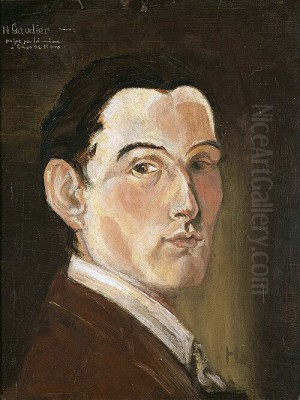
Henri Gaudier-Brzeska stands as a pivotal yet tragically short-lived figure in the landscape of early 20th-century European art. A French sculptor and painter by birth, his most significant contributions unfolded within the vibrant avant-garde circles of London. Associated primarily with the Vorticist movement, Gaudier-Brzeska developed a unique and powerful sculptural language characterized by direct carving and a synthesis of influences ranging from ancient cultures to Cubism. His life, marked by prodigious talent and intense creativity, was cut short by the First World War, leaving behind a legacy that continues to resonate in the study of modern sculpture.
Early Life and Artistic Formation
Henri Alphonse Séraphin Marie Gaudier was born on October 4, 1891, in Saint-Jean-de-Braye, a commune near Orléans in France. His background was modest; his father was a carpenter, suggesting an early familiarity with craftsmanship and materials, though not within a fine art context. Crucially, Gaudier-Brzeska was largely self-taught as an artist. Despite showing an early passion for art, he did not receive formal academic training in sculpture or painting, a fact that perhaps contributed to the uninhibited and experimental nature of his later work. His artistic development was driven by personal study, observation, and an innate talent for form and line.
A decisive moment in his life and career occurred in 1910 when he moved to London. There, he met Sophie Brzeska, a Polish writer significantly older than him. Their relationship was intense, complex, and deeply symbiotic, though reportedly platonic and never formalized by marriage. It was Sophie who profoundly influenced his intellectual development. In recognition of their bond, Henri adopted her surname, hyphenating it with his own to become known as Henri Gaudier-Brzeska. This partnership, while supportive in many ways, was also fraught with difficulties, contributing to the intense emotional undercurrents sometimes perceived in his work and life story.
Immersion in the London Avant-Garde
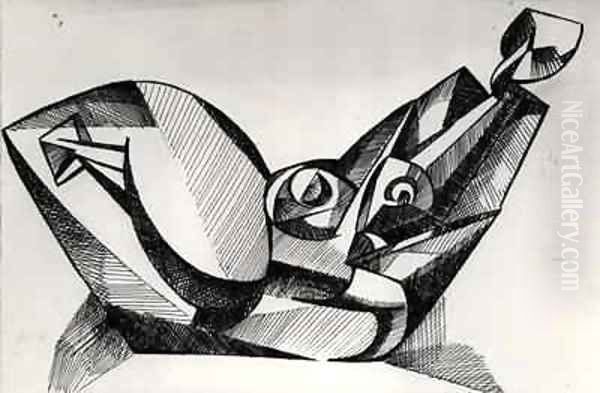
London in the years leading up to World War I was a crucible of artistic innovation. Gaudier-Brzeska quickly immersed himself in this dynamic environment, connecting with key figures who were shaping the future of British art and literature. He became a founding member of The London Group in 1913, an exhibiting society formed by artists breaking away from more conservative institutions, aiming to provide a platform for experimental work. This placed him alongside contemporaries who were exploring new artistic languages.
His network expanded to include influential figures like the American poet Ezra Pound and the painter and writer Wyndham Lewis. Pound, in particular, became a crucial friend, supporter, and intellectual sparring partner. He recognized Gaudier-Brzeska's talent early on, acting as a patron and championing his work. The interactions with Pound, Lewis, and others associated with emerging modernist trends were vital, providing Gaudier-Brzeska with both intellectual stimulation and opportunities to exhibit and develop his ideas within a supportive, albeit often argumentative, community.
The Vorticist Impulse
Gaudier-Brzeska became a central figure in Vorticism, Britain's only significant avant-garde movement before the First World War. Officially launched in 1914 with the publication of the provocative magazine Blast, Vorticism sought to capture the dynamism, energy, and perceived violence of the modern, machine age. Led primarily by Wyndham Lewis, the movement embraced abstraction and geometric forms, rejecting the sentimentality of the Victorian era and the perceived decorative fuzziness of Impressionism and even early Cubism. It shared affinities with Italian Futurism in its celebration of modernity but aimed for a harder, more static intensity rather than simply depicting speed.
Gaudier-Brzeska was a signatory of the Vorticist manifesto published in Blast and contributed essays articulating the movement's sculptural principles. He argued for a sculpture that expressed form directly, celebrating the inherent qualities of the material and the energy of its creation. His association with Vorticism solidified his position at the forefront of the British avant-garde. Key collaborators and fellow Vorticists included Wyndham Lewis, Ezra Pound, the painter Edward Wadsworth, and, through association and influence, the sculptor Jacob Epstein, whose earlier work had already challenged traditional sculptural norms in Britain. Frederick Etchells and Vanessa Bell, though perhaps more associated with the Bloomsbury Group or the Omega Workshops, also moved within these interconnected circles.
Artistic Style and Influences

Gaudier-Brzeska's artistic style is most renowned for its embrace of "direct carving." This approach, contrasting with the prevailing academic method of modeling in clay and then having assistants translate the model into stone or bronze, involved the artist working directly on the final material, usually stone or wood. This method emphasized the physical act of creation, the relationship between artist and material, and the inherent qualities of the stone or wood itself. Tool marks were often left visible, contributing to a sense of immediacy and raw energy. This approach aligned him with other pioneers of modern sculpture like Constantin Brancusi.
His early work showed the influence of Auguste Rodin, particularly in its expressive modeling of the human form. However, he quickly moved beyond Rodin's orbit. Exposure to Cubism informed his increasing use of geometric simplification and faceted planes. Perhaps more distinctively, Gaudier-Brzeska was deeply influenced by non-Western and archaic art forms. He frequented the British Museum, studying African, Oceanic, and Asian sculpture, drawn to their formal power, abstraction, and spiritual intensity. His friend Ezra Pound introduced him to Chinese calligraphy and poetry, elements of which – particularly the emphasis on line and essential form – resonated in his drawings and sculpture. This eclectic mix of influences was synthesized into a unique style that was both modern and seemingly timeless, characterized by dynamism, condensed energy, and a balance between abstraction and figuration.
Representative Works
Despite his tragically short career, Gaudier-Brzeska produced a remarkable body of work, including sculptures and numerous drawings. Several pieces stand out as representative of his style and concerns:
_Hieratic Head of Ezra Pound_ (1914): Carved directly in marble, this iconic portrait is a quintessential Vorticist piece. It depicts his friend and patron not naturalistically, but as a monumental, almost totemic figure. The simplified geometric forms, elongated features, and sense of rigid, contained energy embody Vorticist ideals of hardness and intellectual force. It is considered a landmark of modern portrait sculpture.
_Bird Swallowing a Fish_ (1914): This small marble sculpture exemplifies his interest in animal forms and dynamic energy. The forms are radically simplified and abstracted, merging the two creatures into a single, powerful vortex of action. It captures a moment of primal struggle with Vorticist intensity, showcasing his ability to convey movement and force within a compact form.
_The Dancer_ (c. 1913): Sometimes titled Red Stone Dancer, this piece captures the movement of a figure in mid-motion. Carved in red Mansfield stone, the work balances abstraction with recognizable human form. The twisting pose and simplified planes convey a sense of fluid energy and rhythmic grace, demonstrating his skill in rendering dynamic movement in static material.
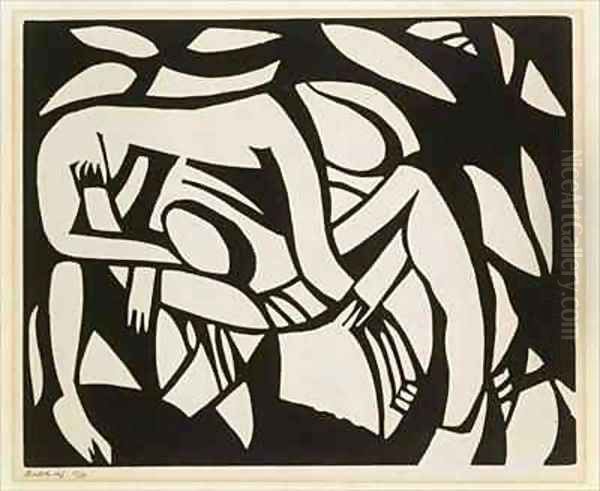
_Wrestlers_ (1914): A relief carving in marble, this work again focuses on the theme of physical energy and struggle. The intertwined figures are highly stylized and reduced to essential geometric forms, locked in combat. It reflects the Vorticist fascination with force and dynamism, rendered with characteristic directness.
_The Seaman_ (or _Torso of a Sailor_) (c. 1914): This work, sometimes identified with different materials including marble, shows his ability to convey robust physicality through simplified, powerful forms, capturing the essence of the subject rather than detailed anatomy.
Drawings and Other Works: Gaudier-Brzeska was also a prolific draughtsman. His drawings, often executed rapidly in ink or charcoal, captured animals, dancers, and figures with remarkable vitality and economy of line. Works like his _Self-Portrait with a Pipe_ (c. 1912-13) show his graphic skill, while series like the _Prometheus_ drawings reveal his engagement with mythological themes and his mastery of depicting muscular form and tension. He also created portraits of contemporaries, such as a bronze bust of the artist Alfred Wallwork and drawings or sculptures related to figures like Horace Brodzky.
Key Relationships and Personal Life
Gaudier-Brzeska's life in London was defined by intense relationships. His connection with Sophie Brzeska was foundational, providing emotional and intellectual companionship, albeit a complex and unconventional one. Her later mental health struggles and institutionalization after his death cast a tragic shadow over their story.
His friendship with Ezra Pound was arguably the most significant for his career. Pound was not just a friend but a tireless promoter, critic, and intellectual catalyst. He purchased Gaudier-Brzeska's work, secured commissions (like the Hieratic Head), and wrote extensively about him, ensuring his place in the narrative of modernism. Their collaboration extended to the Vorticist project, where Pound's literary theories and Gaudier-Brzeska's sculptural practice informed each other.
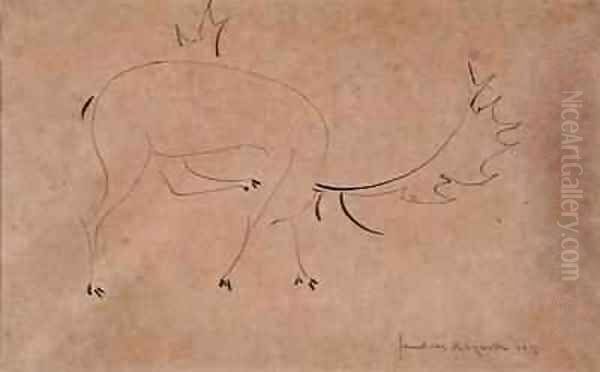
He also maintained connections with other artists and writers. His interactions with Wyndham Lewis were central to Vorticism. He respected Jacob Epstein's pioneering work in direct carving and engagement with 'primitive' art sources. Friendships extended to figures like the Irish poet W.B. Yeats, who was also part of Pound's circle. His involvement with Roger Fry's Omega Workshops, although brief and ending in disagreement, connected him with artists like Vanessa Bell and Frederick Etchells. He moved within a network that included painters like Charles Ginner, demonstrating his integration into the broader London art scene. Anecdotes, such as his time spent studying in Paris libraries like Sainte-Geneviève, hint at a restless intellectual curiosity and engagement with diverse cultural currents.
The Great War and Untimely Death
The outbreak of the First World War in August 1914 dramatically altered the course of Gaudier-Brzeska's life and the trajectory of the European avant-garde. As a French citizen, he felt compelled to enlist in the French army. Despite his connections to the pacifist or ambivalent attitudes of some in the London art world, he embraced military service with characteristic intensity and courage.
He served on the Western Front, experiencing the brutal realities of trench warfare. Reports and his own letters suggest he fought bravely, earning recognition for his conduct under fire, including a medal for bravery mentioned in some accounts. His artistic output continued even in the trenches, where he reportedly carved small sculptures from rifle butts. However, his promising life and career were tragically cut short. On June 5, 1915, Henri Gaudier-Brzeska was killed in action during an assault at Neuville-Saint-Vaast, near Arras, France. He was only 23 years old.
Legacy and Influence
Henri Gaudier-Brzeska's death was a profound loss to modern art. In a career spanning barely five years, he had already established himself as one of the most innovative sculptors of his generation. His primary legacy lies in his pioneering contribution to direct carving and his development of a powerful, abstract sculptural language that synthesized diverse influences into a unique Vorticist aesthetic.
He significantly impacted the course of British sculpture, moving it decisively away from academic conventions towards modernism. His emphasis on material truth, formal simplification, and dynamic energy influenced subsequent generations of sculptors in Britain and beyond. Although Vorticism itself largely dissipated after the war, Gaudier-Brzeska's work transcended the movement's specific timeframe, retaining its power and relevance.
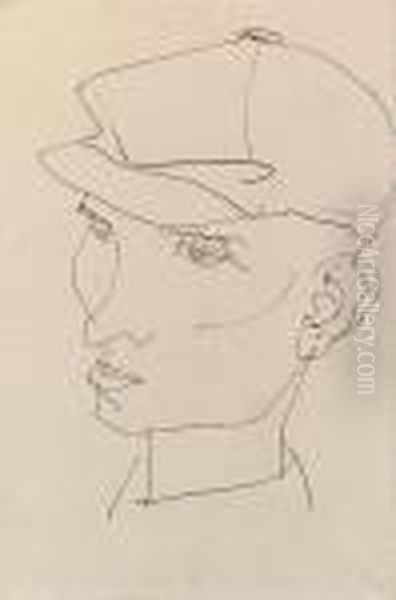
His reputation was carefully preserved and promoted after his death, notably by Ezra Pound, who wrote the memoir Gaudier-Brzeska: A Memoir (1916), and later by H.S. (Jim) Ede, who acquired a large portion of his estate (including works left with Sophie Brzeska) and made it the core of the Kettle's Yard collection in Cambridge, ensuring public access to his work. Artists he interacted with, like Jacob Epstein, continued to shape modern sculpture, carrying forward some of the spirit of direct engagement with form and material that Gaudier-Brzeska had championed. His work remains a testament to a brilliant talent extinguished too soon, a vital link in the chain of modernist innovation.
Conclusion
Henri Gaudier-Brzeska remains a figure of fascination: a largely self-taught artist from provincial France who became a key player in the London avant-garde, a co-founder of Vorticism, and a sculptor of extraordinary originality and power. His embrace of direct carving, his synthesis of global art influences, and his ability to imbue stone and wood with dynamic energy marked him as a major talent. His life was brief, intense, and ultimately tragic, ending on a battlefield before his artistic vision could fully mature. Yet, the work he left behind continues to command attention, securing his place as a crucial pioneer of modernist sculpture whose influence belied the brevity of his career.